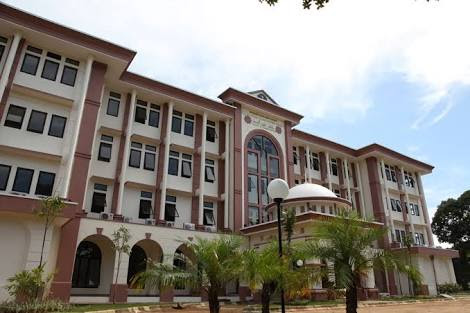DEVELOPMENT OF MATHEMATICAL LITERACY-BASED TEACHING MATERIAL ON MATHEMATICS
PENGEMBANGAN BAHAN AJAR MATEMATIKA BERBASIS LITERASI MATEMATIKA
Abstract
This study aims to produce mathematics teaching material based on literacy. This teaching material is purposively developed and designated for all students, both students with low, medium, and high levels of literacy. Consequently, teachers could easily apply it classically in various learning environments in the class. The design uses the Plomp development model. The research subjects were class VII students of MTsN 3 Central Aceh with instruments in the form of expert validation sheets, practicality assessment sheets, and effectiveness assessments. This study describes the process of developing good-quality textbooks that have fulfilled the criteria of validity, practicality, and effectiveness. The results of expert validation on the material indicator, the average V index score was 0.81, the mathematical literacy indicator was 0.77, the illustration indicator was 0.74, the layout/format indicator was 0.8, and the language indicator was 0.8. Based on these results, it is known that the developed textbooks have fulfilled the valid category. The results of the recapitulation of the practicality questionnaire by the rater have a total score of 137 and a mean score of 45.66. Therefore, the teaching materials are categorized as Very Practical based on the categories used. The tests carried out in the test group showed that the mastery of learning after using textbooks was above 85%, which means that it fulfilled the excellent category, and indicates that the teaching materials developed are effective.
Downloads
References
Akyuz, G., & Pala, N. M. (2010). The effect of student and class characteristics on mathematics literacy and problem-solving in PISA 2003. Elementary Education Online, 9(2), 668–678. Retrieved from https://www.ilkogretim-online.org/?mno=122909.
Cahyono, B., Tsani, D., & Rahma, A. (2018). Pengembangan bahan ajar buku saku matematika berbasis pendidikan karakter materi trigonometri. Phenomenon: Jurnal Pendidikan MIPA, 8(2), 185–199. https://doi.org/10.21580/phen.2018.8.2.2929.
De-Lange, J. (2003). Mathematics for literacy. Quantitative literacy: Why numeracy matters for schools and colleges, 80, 75–89.
Dinni, H. N. (2018). HOTS (high order thinking skills) dan kaitannya dengan kemampuan literasi matematika. PRISMA, Prosiding Seminar Nasional Matematika, 1, 170-176. Retrieved from https://journal.unnes.ac.id/sju/index.php/prisma/article/view/19597.
Diputra, K. K. S., Diputra, K. S., Suarjana, I. M., & Japa, I. G. N. (2019). Investigating the mathematical literacy of primary school students in curriculum 2013. 5th International Conference on Education and Technology (ICET 2019), 65–67. https://doi.org/10.2991/icet-19.2019.16.
Firmansyah, & Gradini, E. (2020). Profil daya serap ujian nasional mata pelajaran matematika SMP/MTS tahun 2019 Se-Kabupaten Aceh Tengah. Jurnal As-Salam, 4(2), 246–259. https://doi.org/10.37249/as-salam.v4i2.184.
Gatabi, A. R., & Stacey, K. (2009). Applying a mathematical literacy framework to the Iranian grade 9 mathematics textbook. Of the 33rd Conference of the International Group for the Psychology of Mathematics Education, 433.
Gradini, E., & Firmansyah, F. (2019). Measuring students’ mathematical literacy in the culturally responsive mathematics classroom. Al-Ta Lim Journal, 26(3), 233–242. https://doi.org/10.15548/jt.v26i3.551.
Grotluschen, A., Mallows, D., Reder, S., & Sabatini, J. (2016). Adults with low proficiency in literacy or numeracy. OECD Education Working Papers No. 131. Paris: OECD Publishing. https://doi.org/10.1787/5jm0v44bnmnx-en.
Han, W., Susanto, D., Dewayani, S., Pandora, P., Hanifah, N., Miftahussururi, M., & Akbari, Q. S. (2017). Materi pendukung literasi numerasi. Jakarta: Kementerian Pendidikan dan Kebudayaan. Retrieved from http://repositori.kemdikbud.go.id/11628/1/materi-pendukung-literasi-numerasi-rev.pdf.
Johar, R. (2012). Domain soal PISA untuk literasi matematika. Jurnal Peluang, 1(1), 30. Retrieved from http://www.jurnal.unsyiah.ac.id/peluang/article/view/1296.
Kholil, M., & Usriyah, L. (2019). Pengembangan buku ajar matematika terintegrasi nilai-nilai keislaman dalam penanaman karakter siswa madrasah ibtidaiyah. Madrasah: Jurnal Pendidikan Dan Pembelajaran Dasar, 12(1), 52–62. https://doi.org/10.18860/mad.v12i1.7442.
Lestari, N. D. S., Juniati, D., & Suwarso, St. (2017). Preliminary study: Mathematics teacher conception in supporting the integration of mathematics literacy and mathematics teaching and learning. Proceeding ICMETA, 1(1). Retrieved from https://jurnal.uns.ac.id/math/article/view/12026.
Li, Y. (2019). Mathematics education and mathematics culture-training mathematics literacy in mathematics education. In 5th International Conference on Education Technology, Management, and Humanities Science (Vol. 10). Retrieved from https://www.webofproceedings.org/proceedings_series/ESSP/ETMHS%202019/ETMHS19374.pdf.
Nieveen, N. (1999). Prototyping to reach product quality. In Design approaches and tools in education and training (pp. 125-135). Dordrecht: Springer. https://doi.org/10.1007/978-94-011-4255-7.
OECD. (1999). Measuring student knowledge and skills: A new framework for assessment. Paris: OECD Publishing.
OECD. (2009). Assessment framework-key competencies in reading. mathematics and science. Paris: OECD Publishing.
OECD. (2019). PISA 2018 results (volume I): What students know and can do. Paris: OECD Publishing.
Ojose, B. (2011). Mathematics literacy: Are we able to put the mathematics we learn into everyday use? Journal of Mathematics Education, 4(1), 89–100.
Owens, J. E. (1988). Curriculum and evaluation standards for school mathematics: Report of the national council of Teachers of Mathematics' Commission on standards for school mathematics. Paper presented at the Summer Workshop of The Association of Teacher Educators. The University of Alabama. Retrieved from https://eric.ed.gov/?id=ED302515.
Plomp, T., & Nieveen, N. (2013). Educational design research. Enschede: Netherland Institute For Curriculum Development (SLO).
Retnawati, H. (2016). Proving content validity of self-regulated learning scale (The comparison of Aiken index and expanded Gregory index). REiD (Research and Evaluation in Education), 2(2), 155–164. https://doi.org/10.21831/reid.v2i2.11029.
Saefurohman, S., Maryanti, R., Azizah, N. N., Al Husaeni, D. F., Wulandary, V., & Irawan, A. R. (2021). Efforts to increase numeracy literacy of elementary school students through quizzes and learning media. ASEAN Journal of Science and Engineering Education, 1(3), 167–174. Retrieved from https://ejournal.upi.edu/index.php/AJSEE/article/view/38570.
Styawati, R. D., & Nursyahida, F. (2017). Profil kemampuan literasi matematika siswa berkemampuan matematis rendah dalam menyelesaikan soal berbentuk PISA. AKSIOMA: Jurnal Matematika dan Pendidikan Matematika, 8(2), 33-42. https://doi.org/10.26877/aks.v8i2.1839.
Susanti, E., & Syam, S. S. (2017). Peran guru dalam meningkatkan kemampuan literasi matematika siswa Indonesia. In Prosiding dipresentasikan dalam Seminar Matematika dan Pendidikan Matematika UNY. Retrieved from http://seminar.uny.ac.id/semnasmatematika/sites/seminar.uny.ac.id.semnasmatematika/files/full/M-41.pdf.
Copyright (c) 2023 Firmansyah B., Muhammad Rijali Rais

This work is licensed under a Creative Commons Attribution 4.0 International License.

